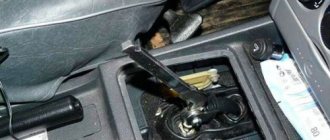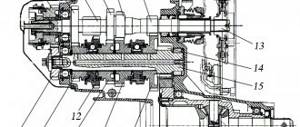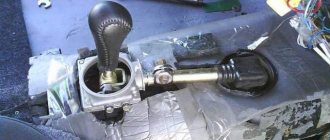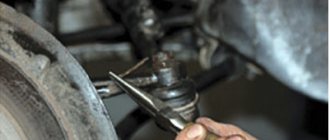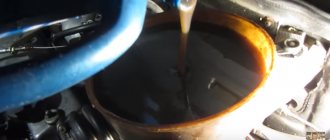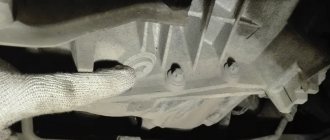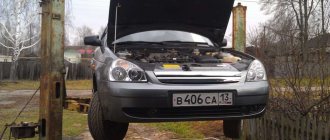The GAZ-53 truck is perhaps the only car that has not been produced for 20 years, but is still in use by most people and enterprises. This is all thanks to the high-quality assembly and the parts used from which the individual components of the truck were created.
This is what the original GAZ 53 looks like
The gearbox diagram is constructed as follows. The front end of the input shaft is fixed in the bearing of the engine crankshaft, the rear end of the shaft is connected to the secondary shaft through a needle bearing.
The intermediate shaft transmits all movements to the secondary shaft; depending on the selected speed, the gear ratio changes and, accordingly, the speed at which the car moves. The fourth gear is direct; in this gear, the clutch connects the primary and secondary shafts.
Example of a gearbox for GAZ-53
From the shank of the secondary shaft, through the propeller shaft, the movement enters the rear axle, which rotates the rear wheels.
Creation of the GAZ 53 checkpoint
The first releases of the GAZ 53 (with the index “F”) were equipped with a six-cylinder engine and a GAZ 51 rear axle. The gearbox was also taken from the 51st, but it was modernized. It should be noted that it is possible to replace the GAZ 53 gearbox with a GAZ 51, but it does not always make sense to do this. The fifty-first box has different gear ratios. In addition, it is designed for a less powerful engine and lower load capacity.
Due to the fact that the production of the GAZ 53F was discontinued in 1967, the old modification was replaced by the improved GAZ 53A.
This car was already equipped with a powerful V-shaped 8-cylinder engine, so a new rear axle had to be designed on the new model and the gearbox had to be improved.
Example of a GAZ 53F truck
On earlier versions of the gearbox, synchronizers for the third and fourth gears were installed, which are designed to smooth out the moment the gearbox is engaged, but in later versions of the gearbox the synchronizers were removed, considering them unnecessary. All that's left is the shift clutch. Gearboxes without synchronizers began to be used on the GAZ 3307.
Why do you need a gearbox slide?
In fact, most often the gearbox is in good condition, but the rocker may fail.
You can replace the unit with a new one, or you can get by with proper adjustment of the rocker. Adjusting this element will help troubleshoot problems and make sure that the problem is related specifically to the gearbox linkage. It happens that a car owner simply begins to change one component after another without understanding the problem, wasting money and time to no avail.
The gearbox itself is designed to prevent gears from switching spontaneously . It happens that due to incorrect or erroneous adjustments, the entire transmission system begins to work incorrectly and may even fail. Therefore, you need to be able to adjust the gearbox rocker with your own hands, especially since this procedure is not complicated.
When does the rocker need adjustment?
Gear shift mechanism.
The procedure for adjusting the gearbox linkage is recommended in the following cases:
- After the transmission on the car has been replaced or removed.
- When loosening the fixing clamps.
- If the cardan was changed.
- If the link starts to rotate on its hinge.
Although visually it may seem that the rocker is in place, even the slightest movement of the rocker can lead to incorrect operation of the gearbox. It happens that it is enough to tighten the link to the cardan by 1 mm, after which all functions of the gearbox will be restored.
Diagram of the GAZ-53 gearbox
Here we will talk about the gearbox of the famous GAZ 53 truck.
Design and diagram of a gearbox from a GAZ 53 truck.
The gearbox on this truck has four forward speeds and one reverse. It is mechanical, consisting of three shafts: drive, driven, intermediate. The GAZ 53 gearbox is designed for three strokes.
Thanks to the gearbox, it is possible to transfer the speed that the engine develops to the drive wheels, while changing the amount of traction force. If necessary, using the gearbox, you can stop transmitting these revolutions to the drive wheels. This corresponds to the neutral position of the gear lever.
Positions of the GAZ-53A gearbox shift lever.
How to adjust the rocker on a VAZ 2110 with your own hands
Before adjusting the gearbox linkage, it is necessary to perform a number of preparatory work:
- Drive the car into the pit.
- Tighten the handbrake and install the wheel chocks.
Method No. 1 - adjusting the rocker according to the rear speed.
- Loosen the clamp.
- Engage reverse and position the lever as you would like it to be in that position.
- Then tighten the clamp and check how the rocker works, whether you are satisfied with the current position of the lever and the operation of the rocker.
Method No. 2 - adjusting the rocker at first speed.
This method is used, as a rule, when the first method did not produce results.
- Turn on first speed.
- Loosen the rocker clamp.
- Turn the rocker drive counterclockwise until the gearshift lever begins to rest against the plastic reverse speed stop.
- Tighten the clamp and check how everything works.
Method No. 3 - adjusting the scenes in neutral.
If you do not have a plastic stopper, the adjustment is made in neutral gear.
To adjust the neutral position of the gearshift lever, you need to accurately calculate the depth of the shift of your gearbox to the driveshaft of the VAZ 2110. Sometimes such manipulations result in the appearance of annoying rattling of the lever.
If adjusting the rocker does not lead to anything and there is still a problem with switching, replace the rocker completely or ask for help from specialists.
Technical characteristics of the GAZ 53 gearbox
The gearbox of GAZ 53A and GAZ 53 12 trucks has the following technical characteristics:
- Box type – mechanical;
- Type according to the position of the shift lever - three-way;
- Number of forward gears – 4;
- Number of reverse gears – 1;
- Weight – 56 kg;
- Filling capacity – 3 l.
- first speed – 6.55;
- second speed – 3.09;
- third speed – 1.71;
- fourth speed – 1;
- reverse speed - 7.77.
Return to contents
Malfunctions of the GAZ 53 gearbox
Symptoms of a problem
A faulty gearbox can be judged by the following signs:
- noise in the gearbox area;
- the speeds do not turn on at all, or with great difficulty;
- One of the speeds does not turn on;
- one or more speeds are out of whack;
- There is a grinding noise in one or more gears while driving;
- The speed does not turn off, and the car drives in only one gear. The gearshift lever does not move to the neutral position.
We have long wanted to test the most “people’s” bus, PAZ-3205. Since Soviet times, the main consumers of the PAZ-3205 were villagers who used these buses to travel from remote villages to regional centers. Various modifications of the PAZ-3205 are widely used for transporting construction workers, factory workers, and shift workers at oil and gas developments. In small towns, “pasikis,” as they are affectionately called by people, operate regular buses. Even beyond the Arctic Circle they have found application. And recently they have mastered another “profession” - minibus taxi in large cities. So the PAZ-3205 is a popular and truly “people's” bus. What are the buses of the Pavlovsk plant?
Many of our readers were probably surprised by the question posed - “grooves” have been coming off the assembly line for a long time, and have been used by numerous customers for many years. And why test buses that everyone already knows? One could agree, but...
About six years ago we had the opportunity to become closely acquainted with two “grooves” - diesel and gasoline. The cars were new, smelling of paint and had virtually no mileage. There were, frankly, a lot of problems with them; my head was spinning. For example, during maneuvers on the turning loops of the testing ground's dynamometer road, the side glass of one of the buses fell out of the opening (the opening turned out to be larger than the glass itself). On one of the buses the gearbox gears were difficult to engage, and we were unable to engage one of the gears. The outside mirrors were poorly secured and fell off due to vibration. In short, six years ago there were more than enough defects. So I wanted to see whether the “people’s” buses have changed for the better during this time or not?
So, three Pavlovsk buses were included in the editorial tests: PAZ-32053 with a ZMZ-5234.10 gasoline engine, mileage 27,000 km; PAZ-32053-07 with a diesel engine MMZ-245.7, mileage 28,000 km and PAZ-4234 with an extended chassis, increased capacity, more powerful diesel engine MMZ-245.9E2, mileage 15,400 km.
The higher quality of body manufacturing immediately caught my eye. If six years ago, even inside the cabin, uncooked welded seams covered with rust were visible, but today the bodies of Pavlovsk buses have all the seams well welded, primed and painted. The ventilation hatches close tightly and do not let water through during rain, unlike buses six years ago. The glass no longer falls out of the openings when turning corners. In general, the quality of assembly and painting of bodies has improved by several orders of magnitude. Moreover, the bodies now undergo special anti-corrosion treatment, including filling hidden cavities with Dinitrol, and they are given a six-year factory warranty against through corrosion. Well, there is progress...
PAZ-32053 with a gasoline engine ZMZ-5234.10 and PAZ-32053-07 with a diesel unit MMZ-245.7 have a standard chassis and body with one double-leaf passenger entrance door with a pneumatic drive. The back door of both buses is considered an emergency exit. The interior layout and arrangement of passenger seats are the same for the cars, but they differ in passenger capacity and number of seats. The number of seats for PAZ-32053 is designed for 25 people, and for PAZ-32053-07 - for 22. Accordingly, the buses are “packed” differently: in PAZ-32053 - 41 people, and in PAZ-32053-07 - 37.
Adjusting the gear shift drive
Before regulating anything, you need to have an idea of how this or that mechanism works, how it works, etc. First, let's look at the design and principle of operation of a manual gearbox (gearbox) in general terms.
The gearbox converts and transmits torque from the engine to the drive wheels so that the car can move off and change speed. There are four types of gearboxes: manual, automatic, robotic and CVT.
The first two types are the most common today. Taking into account the fact that a manual transmission or “mechanics” has a simpler design, we will consider just such a unit as an example.
A mechanical transmission is, relatively speaking, a set of shafts (input and output) and a set of gears on each of the shafts. The gears on the shafts mesh and thus interact with each other.
Like any other mechanism, the shift drive has certain settings that get lost over time. This may cause problems with transmission control. In other words, if the gears are difficult to engage, there can be many reasons, one of them being the need to adjust the drive.
By and large, all adjustment of the gear shift mechanism in a garage comes down to working on the gear selection rod. It is also called the backstage. In a nutshell, the linkage is the device that connects the gearshift lever to the gearbox. When it wears out, problems arise such as:
- increase in shift lever play;
- incorrect gear selection (another one is switched on instead of the selected one);
- when switching you have to put in more effort than before;
- Extraneous sounds occur when the lever moves.
To adjust the gear shift rod you will need the following tools:
You can adjust it in two simple ways. There will be one common action for them: loosen (and then tighten again) the rocker clamp. Its location may vary depending on the model and make of the car (you can check it in the manual).
- In reverse gear. The method allows you to solve the problem of incorrect activation of speeds in the vast majority of cases. It consists in the fact that after loosening the clamp (you will need a key for this), reverse gear is engaged (with the engine turned off, in compliance with safety precautions). The shift lever is set to the desired position and the clamp is tightened again.
- Also, gear shift adjustment can be carried out in first gear. To do this, you need to turn it on and then loosen the clamp. Next, the rocker drive is rotated clockwise until the gearbox selector hits the plastic stop of the reverse gear. It feels good. Then the clamp is tightened again, after which the adjustment can be considered complete.
PAZ-32053 with a gasoline engine ZMZ-5234.10
It is probably incorrect to compare the car of today with its “brother” from six years ago in terms of power unit. At that time we were dealing with a completely new car, the same sample had been tested a long time ago, and all the “childhood diseases” were eliminated by the PAZ drivers during operation.
The engine idles quietly. The noise is created only by the pneumatic compressor, and the squelching sound of the operating compressor is similar to the squealing of a black grouse. But when the engine speed increases, a characteristic sound appears, somewhat reminiscent of the operation of the engine of an old GAZ-53 truck. Naturally, in this case you can no longer hear the pneumatic compressor.
The starting dynamics of the petrol PAZ are quite good - the engine power is still 130 hp. With. The gearbox engaged in gears without problems, except for two – fifth and reverse. For some reason, the fifth gear was engaged all the time with a “breakdown”, i.e. with a slight grinding sound, the reverse gear was also difficult, but for a different reason - there was not enough space.
And the road dynamics of the PAZ-32053 are good. To my surprise, the gas pedal worked without problems: like on imported cars, without delays and smoothly. Therefore, it was not difficult to maintain a constant speed during fuel consumption measurements.
Until 2003, PAZ buses were equipped with a braking system consisting of two circuits: hydraulic and pneumatic, like on trucks from the Gorky Automobile Plant. Since 2003, Pavlovsk residents have modernized the braking system, and it has become completely pneumatic, which made it possible to install ABS from Knorr-Bremse.
But the location of the brake pedal remains inconvenient: it is installed at different levels with the gas pedal.
The hydraulic clutch pedal is poorly positioned - very high. In city traffic jams, when the driver constantly keeps his foot on the clutch pedal, the inconvenience turns into leg pain. By the way, our version is also confirmed by the drivers of PAZ “route” taxis operating in cities. On suburban routes, PAZ drivers do not have this problem: they don’t have to keep their foot on the clutch pedal for long.
As for maneuverability, Pavlovsk buses have always been distinguished by good handling and maneuverability. Suffice it to say that with an overall turning radius of 8.5 m, the bus turns on a road 6 m wide in two steps. It should be noted that the power steering worked well - with such a turn, you had to turn the steering wheel in place. On a gasoline “groove” the power steering worked silently and easily.
There were no complaints about the chassis during testing either. Buses PAZ-32053 and PAZ-32053-07 are equipped with bridges from the Ryazan Automotive Units Plant (RZAA) or the Kanash Automobile Units Plant (KAAZ). In our case, bridges made in Ryazan were installed on both grooves. Apparently, this is why the gearboxes did not emit the characteristic howling sound inherent in the axles of Gorky trucks. The Ryazan plant also produces rear axles for the Moscow ZIL automobile plant.
PAZ-32053-07 with a Minsk diesel engine
Everything that has been said about the design and layout of a bus with a gasoline engine is fully true for a car with a diesel engine. The main difference is the Minsk-made MMZ D-245.7 engine. It’s hard not to notice him when standing next to a bus with its engine running. You can immediately say: “He! Tractor "Belarus". PAZ specialists worked for a long time to reduce the noise of not only the engine, but also the entire bus as a whole, and as a result, its level was brought to the required certification standards, but the feeling of a tractor engine remained.
Inside the cabin, the engine is not very noisy, especially in comparison with the diesel PAZ six years ago. On that bus you had to talk with your voice very loud.
It cannot be said that a diesel car is significantly different from a gasoline car in terms of dynamic performance. But its fuel consumption is significantly lower, which has a very good effect on the profitability of the bus.
Technical characteristics of buses PAZ-32053, PAZ-32053-07, PAZ-4234
What’s most interesting is that the PAZ-32053-07 and PAZ-4234, which corresponds to the middle class and has a more powerful MMZ-245.9E2 diesel engine, have very similar fuel consumption figures. Please note that the motor is positioned as meeting Euro 2 environmental standards.
The extended bus is also equipped with a Zilov-made, but reinforced axle ZVL-433100 (RZAA) and a “Zilov” 5-speed manual gearbox made by the Smolensk plant, as on previous models.
Naturally, the “long” PAZ has slightly worse dynamics than its “short” counterparts, but the passenger capacity is 50 people, i.e. 10...11 people more than the small class PAZs. The car has rationally arranged passenger seats, and storage areas are organized opposite the two doors with pneumatic drive.
SPECIAL OPINION
Conducting editorial tests on the test roads of the Federal State Unitary Enterprise NITSIAMT, you somehow forget that this is a place of increased concentration of new models of the global automotive industry. The streets of Moscow and highways aimed at Europe have recently turned into a permanent Motor Show and also cannot reflect the general situation on the roads of the entire country. And the homespun truth is that in the vast Russian expanses, the products of the former Automotive Industry and its bus component, in particular, will obviously rule the roost for a very long time. In Soviet times, regular KAVZs and PAZs, especially all-wheel drive ones, were the main means of suburban transport, especially in rural areas. Since then, PAZ has almost photographically preserved the appearance of its products and its leading position in the production of buses. If among the bus factories that found themselves in the abyss of perestroika processes, there was a prize “For the will to win”, then it would have been registered in the city of Pavlov on good grounds.
As for the interior and the driver’s workplace, they “brought together” at least three generations of passengers and drivers. Honored pensioners do not need to tell their grandchildren what buses they had to ride on, and a young, inexperienced driver may well take a master class from his father or grandfather, who drove Pavlovsk cars several decades ago. But the high need for PAZs in the country cannot be explained by continuity alone. In the technical and marketing aspects, dramatic changes have occurred, determined by the strategy, which, in addition to Pavlovsky, includes the Likinsky, Kurgan and Golitsynsky bus plants.
Today, along with the traditional gasoline bus, a diesel version is also offered, equipped with MMZ-245 engines in various modifications, which has an incredible impact on its fuel efficiency. Based on a preliminary assessment of the fuel consumption values obtained as a result of measurements, it can be assumed that the reduction in operating fuel consumption can be up to 10 liters, or in the advertising form “25 free kilometers” compared to a gasoline car.
Installing a diesel engine makes it easier to solve problems related to environmental requirements. The development of middle-class buses (PAZ-4234 - an extended version of PAZ-3205) also looks economically justified, which allows increasing passenger capacity from 37 to 50 people with minimal costs for changing production. The main direction of the strategy aimed at reducing production costs was the refusal to use energy-intensive stamping production and the transition to a tubular body frame with priority use of plastic external panels; a similar technology was tested on the new serial bus PAZ-4230 of the Aurora family, which is already widely represented on market. But there is one significant point: the price of the Aurora is approximately twice the cost of even the most expensive diesel version of the almost antique PAZ-3205. This means that our veteran still has hope for many, many years of working life. And either fortunately or unfortunately, we are not used to the general level of this machine.
Section 2. CONTROLS AND OPERATION OF THE PAZ-32053 BUS
CONTROLS AND CONTROL INSTRUMENTS OF THE PAZ-32053 BUS
The location of the controls is shown in (Fig. 2-1 a). To the right of the driver's seat are the gearbox control lever and the parking brake handle. The gear shift diagram is shown on plate 10 of the instrument panel and fig. 2-1 b.
Rice. 2-1 Controls: a – driver’s workplace; b – gear shift diagram. 1-end of the door locking rod; 2- bag; 3-door opening handle; 4-handle for driver's landing; 5- switch for headlights, direction indicators and sound signal; 6- instrument and starter switch; 7- switch for windshield wiper, windshield washer and sound signal; 8- instrument panel; 9-window defroster; 10 - plate with gear shift diagram; 11- radiator shutter control circuit; 12- fuse block; 13-gearbox lever; 14- engine hood; 15- hood fastener; 16- hood handle; 17- handbrake handle; 18- fuel supply control pedal; 19- brake pedal; 20 - cabin ventilation damper; 21-clutch pedal; 22-socket
Rice. 2-2 Diagram of the position of the instrument switch and starter key
Instrument and starter switch 7 (Fig. 2-1) is located on the steering column. In Figure 2-2. The diagram of the position of the instrument switch and starter key is shown:
“III” – in this position the key is inserted and removed from the switch. Regardless of whether the key is inserted or not, the steering shaft is locked with an anti-theft device, but you can turn on the hazard lights, door drive, portable lamp, turn on or off the batteries;
“0” – in this position the anti-theft device is disabled. To turn off the anti-theft device, you need to insert the key into the switch (position “III”) and, slightly shaking the steering wheel left and right, turn the key to position “0”.
“I” – in this position, control and measuring instruments operate and switching on of electricity consumers is possible.
“II” – in this non-fixed position the starter is turned on.
To turn off the devices, turn the key from position I to the fixed position 0.
To avoid failure of the contact part of the instrument switch, do not leave the key in an intermediate position.
Switch for headlights, direction indicators and horn. The switch lever has six fixed positions (Fig. 2-3) - I, II, III, IV, V, VI and four non-fixed positions “A”.
How to adjust the link to the groove 32053
Adjusting the gear shift drive
Adjustment may be required after removing and reinstalling the gearbox, as well as in case of unclear gear shifting during vehicle operation.
You will need: keys “13”, “17”, screwdriver.
1. From below the car, loosen and unscrew the nut of the clamp bolt on the transmission control rod by 3–5 turns.
2. Use a screwdriver to slightly widen the groove of the clamp and the groove at the end of the rod to ensure free movement of the rod relative to the gear selection rod, and set the rod to the neutral position.
3. Inside the car, remove the gear shift lever cover from the floor tunnel housing, lift the cover up along the lever and install the lever so that its lower (non-bent) end is approximately vertical.
4. From below the car, using light hand movements (so as not to move the gear selector levers), select the axial play of the rod in the rearward direction and its angular play in the counterclockwise direction.
5. Tighten the nut of the clamp bolt, installing the clamp at a distance of 1–3 mm from the end of the rod.
Section 2. CONTROLS AND OPERATION OF THE PAZ-32053 BUS
CONTROLS AND CONTROL INSTRUMENTS OF THE PAZ-32053 BUS
The location of the controls is shown in (Fig. 2-1 a). To the right of the driver's seat are the gearbox control lever and the parking brake handle. The gear shift diagram is shown on plate 10 of the instrument panel and fig. 2-1 b.
Rice. 2-1 Controls: a – driver’s workplace; b – gear shift diagram. 1-end of the door locking rod; 2- bag; 3-door opening handle; 4-handle for driver's landing; 5- switch for headlights, direction indicators and sound signal; 6- instrument and starter switch; 7- switch for windshield wiper, windshield washer and sound signal; 8- instrument panel; 9-window defroster; 10 - plate with gear shift diagram; 11- radiator shutter control circuit; 12- fuse block; 13-gearbox lever; 14- engine hood; 15- hood fastener; 16- hood handle; 17- handbrake handle; 18- fuel supply control pedal; 19- brake pedal; 20 - cabin ventilation damper; 21-clutch pedal; 22-socket
Rice. 2-2 Diagram of the position of the instrument switch and starter key
Instrument and starter switch 7 (Fig. 2-1) is located on the steering column. In Figure 2-2. The diagram of the position of the instrument switch and starter key is shown:
“III” – in this position the key is inserted and removed from the switch. Regardless of whether the key is inserted or not, the steering shaft is locked with an anti-theft device, but you can turn on the hazard lights, door drive, portable lamp, turn on or off the batteries;
“0” – in this position the anti-theft device is disabled. To turn off the anti-theft device, you need to insert the key into the switch (position “III”) and, slightly shaking the steering wheel left and right, turn the key to position “0”.
“I” – in this position, control and measuring instruments operate and switching on of electricity consumers is possible.
“II” – in this non-fixed position the starter is turned on.
To turn off the devices, turn the key from position I to the fixed position 0.
To avoid failure of the contact part of the instrument switch, do not leave the key in an intermediate position.
